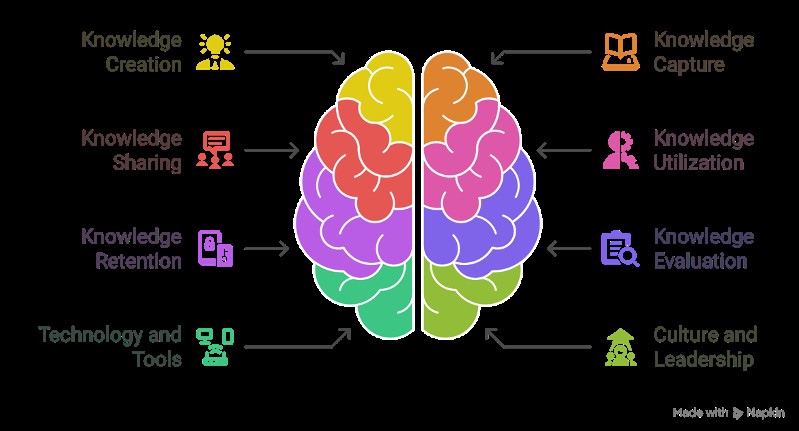TechTalk Daily

April 13th By Daniel W. Rasmus, Serious Insights
As we move deeper into the era of artificial intelligence, it is important to not just tie knowledge management to the development of AI, but to resist knowledge management principles to establish a foundation for where the conversations between AI teams and KM practitioners need to take place. This post offers an simple answer to the question, What is Knowledge Management?
(cover image by OpenAI from a prompt by the author.)
What is Knowledge Management? Eight Foundational Ideas. Made with Napkin from a prompt written by the author.
Knowledge creation starts with environments that encourage inquiry and experimentation. It’s not always about invention—it’s often about synthesis. When people are empowered to reflect, collaborate, and think critically about what they know and what they need to know, new knowledge emerges. Organizations that prioritize knowledge creation design workflows that accommodate serendipity and learning—not just execution. This is where strategy and insight first come into play, long before documentation or tooling.
Capturing knowledge requires intentional design. Not everything people know is captured by default—especially when knowledge lives in experiences, practices, or intuition. Effective capture strategies bridge the gap between tacit and explicit knowledge. That might mean documenting lessons learned, recording decisions, or building structured ways to reflect on projects. Without capture, knowledge evaporates with turnover and time.
Sharing knowledge is a social act, not just a technical one. Systems alone won’t make it happen. It depends on culture, trust, and the belief that what you know is valuable to others. Good KM programs build incentives and norms around contribution. They create physical and digital spaces for sharing—places where expertise meets need. And they help people move from hoarding to helping, especially in hierarchical or siloed environments.
Utilization is where knowledge earns its keep. It’s not enough to store it—it has to inform action. Utilization happens when knowledge is easy to find, relevant, and trustworthy. It also requires alignment with workflows and decisions. If people can’t apply knowledge in context, they won’t use it. The best KM efforts integrate knowledge access where the work happens, reducing friction and increasing confidence in use.
Discover the final 4 Critical Ideas—click to continue at SeriousInsights.net!
About the Author:
Daniel W. Rasmus, the author of Listening to the Future, is a strategist and industry analyst who has helped clients put their future in context. Rasmus uses scenarios to analyze trends in society, technology, economics, the environment, and politics in order to discover implications used to develop and refine products, services, and experiences. He leverages this work and methodology for content development, workshops, and for professional development.